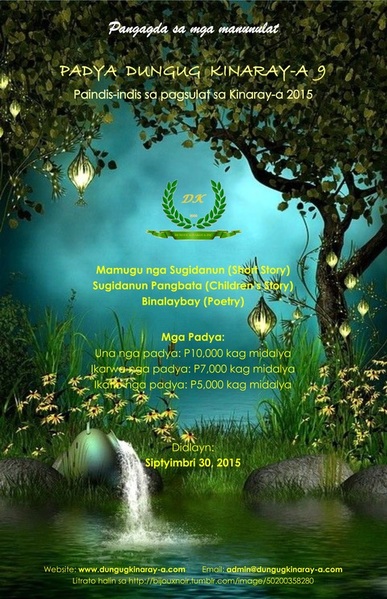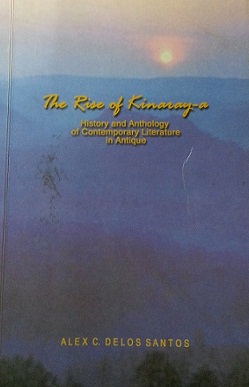
Kinaray-a is the language spoken mostly in West Visayas. It is spoken in Antique, where I come from.
Writer Alex de los Santos , author of the book, “The Rise of Kinaray-a”, said Kinaray-a is also spoken in some parts of Aklan and Capiz, most of Iloilo and even in Negros Occidental where the biggest number of sakadas, seasonal workers in haciendas, is Karay-a from Antique.
There’s a group of Antiqueños, who has taken up the advocacy of keeping Kinaray-a alive because language gives a person identity and reveals the richness of his culture. They maintain a website, “Dungug Kinaray-a Inc.”
U.S. based Ritchie D. Pagunsan, one of the primemovers of Dungug Kinaray-a alerted me to this year’s Kinaray-a writing contest .
Here’s the announcement in kinaray-a:
Padya Dungug Kinaray-a 9 (2015)
Ginapanawagan ang mga manunulat Karay-a!
Magpasakup sa ikasyam nga tuig ka paindis-indis sa pagsulat sa Kinaray-a kang mamugu nga sugidanun, sugidanun pangbata, kag binalaybay. Bukas dya asta sa Siptyimbri 30, 2015. Ang mga madaug makabaton kang P10,000 kag midalya (una nga padya), P7,000 kag midalya (ikarwa nga padya), P5,000 kag midalya (ikatlo nga padya).
Lagtika ang kawad (link) kon paano magpasakup: http://dungugkinaray-a.com/giya-kag-pagsurundan-2015.html
Dali, ipabugal ta ang atun duna nga panghambal. Atun gid dya!
Entries could be short story, children’s story or poem. Deadline for submission of entries is Sept. 30, 2015.
Prizes: first – P10,000 and medal; second – P7,000 and medal; third – P5,000 and medal.
For more details, click on the link provided in the announcement.
Dungug Kinray-a enjoins every Kinaray-a speaking citizens to join and be proud of their language. It is ours.
This pride of Kinaray-a is one of the legacies of Antique’s beloved governor, Evelio Javier, whose death while protecting the votes of Cory Aquino in the 1986 snap elections against Ferdinand Marcos, triggered People Power that ousted Marcos.
Antiqueños have always suffered from inferiority complex being the poorest province in the island of Panay (the other provinces are Iloilo, Capiz and Aklan). In the days when Negros was sugarland, Antique was the source of sakadas, who labor in the sugarcane fields of the haciendas in Negros Occidental.
When the charistmatic Evelio Javier became governor he worked on making Antiqueños rediscover the richness of their culture. He encouraged Antiqueños to feel proud of being an Antiqueño. That included speaking Kinaray-a.
Before, Antiqueños would speak Ilonggo or Hiligaynon, ashamed of Kinaray-a.
De los Santos said Kinaray-a is the original language and could be considered superior to Hiligaynon.
There’s a lot of similarities between Kinaray-a and Hiligaynon. But there are distinguishable differences like the “r” in the former becoming “l” in the latter. Example: the English word “none” is “wara” in Kinaray-a. It’s “wala” in Hiligaynon. Or the word “post” is “harigi” in Kinaray-a and “haligi” in Hiligaynon.
De los Santos explained that ”In Hiligaynon society, the Chinese of old Parian, now Molo, cannot pronounce the “r” so they replaced it with “l”. Since they were the commercial power, the natives followed the way they pronounced some words.
De los Santos also said the Spanish friars, who settled in Iloilo also changed the “d” to “r” as in the word for coconut shredder “kudkudad.” In Hiligaynon, it’s “kudkuran.”
“In summary,” De los Santos said, “Kinaray-a is the original language and Hiligaynon the ‘corrupted’ language, as the result of the speech deficiencies of the Chinese merchants and the Spanish priests, and the loan words from Spanish, CEbunao, Bikol and Waray introduced by the friars.
De los Santos quoted Hiligaynon writer Santiago Alv. Mulato saying, “Kinaray-a was not adulterated because like a jar already full of water, a drop from above could not add to it anymore.”
In sponsoring this writing contest, which is on its 9th year, Dungug Kinaray-a said it is part of its mission to encourage more extensive use of Kinaray-a. (Malapnagun nga ginagamit ang Kinaray-a sa mga pagsugidanun, pagsulat, pagpasundayag kag pagtuon; ginakilala ang Kinaray-a bilang linggwahe nga hamtung kag may kabug-usan; kag maabot ang tion nga ang kada Karay-a makabatyag kang bugal sa paggamit kang ana duna nga panghambal.)
Dungug Kinray-a believes that Kinaray-a is a beautiful, deep, pure, and rich language. “Ang Kinaray-a matahum, madalum, matuod, matam-is, kag manggadan. Bukun dya ti labaw ukon kubus nga harambalun, kag bisan tuod bukas sa pagsimpon agud mangin mas madalum kag mas matayog, ang Kinaray-a puraw, nga angay sa buta nga tadyaw, indi masimbugan kang tinaga nga pangayaw.”
A laudable project that every Antiqueño should support.
